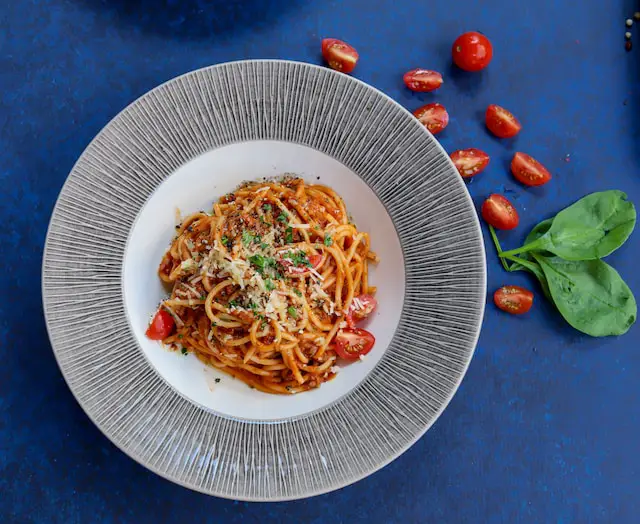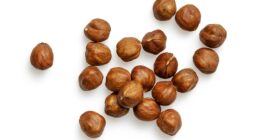Pasta is made from durum wheat flour and water, while noodles can be made from a variety of ingredients such as rice or even potatoes. Pasta is typically associated with Italian cuisine, while noodles are often seen in Asian dishes.
Pasta
(Photo by Olayinka Babalola on Unsplash )

Pasta, a staple in Italian cuisine, has become a worldwide favorite and is beloved by people of all ages. Made primarily from wheat flour and water, this versatile ingredient can be shaped into numerous forms such as spirals, tubes, ribbons, or even tiny shapes like stars. The variety doesn’t end there; some pasta types also incorporate eggs or vegetables for added flavor and color.
Traditionally handmade in Italy, the process involves kneading the dough until smooth before rolling it out and cutting it into desired shapes. Nowadays, many households rely on store-bought pasta due to its convenience – available either fresh or dried.
The beauty of pasta lies not only in its diverse range of shapes but also in the countless ways it can be prepared. From simple olive oil-based sauces to creamy Alfredo and hearty meaty Bolognese – there’s a pasta dish that suits every taste bud! Pairing your favorite type with the right sauce creates a delightful symphony of flavors that leaves you craving more.
Noodles
(Photo by Jan Nguyen 🍁 on Unsplash )

Noodles are a staple in Asian cuisine and have become increasingly popular worldwide. They come in various shapes, sizes, and textures made from different types of flours such as wheat, rice, or mung bean starch.
One popular type of noodle is the Japanese soba noodle made from buckwheat flour. It has a nutty flavor and is often served cold with dipping sauce or hot in soups.
Another well-known noodle is the Chinese egg noodles made with wheat flour and eggs that give it its yellow color. These noodles are commonly used in stir-fries or served alongside vegetables and meats.
Rice noodles are another popular option for gluten-free eaters as they’re typically made solely from rice flour. They’re commonly found in Thai dishes such as Pad Thai.
Noodles are versatile and can be prepared in countless ways making them an excellent addition to any meal!
Pasta Vs. Noodles – Key differences
Pasta and noodles may look similar, but they are not the same thing. The main difference is that pasta is made from durum wheat semolina while noodles can be made from a variety of ingredients including rice, wheat flour, and potato starch.
Another key difference between the two is their texture. Pasta has a denser and firmer texture compared to noodles, which tend to have a softer and chewier texture. This is because pasta dough requires more kneading and rolling than noodle dough.
When it comes to cooking time, noodles usually cook faster than pasta due to their thinner shape. They also absorb flavors better due to their porous nature compared to pasta.
In terms of cultural origin, pasta originated in Italy while noodles are believed to have originated in China thousands of years ago. This explains why there are many different types of Asian-style noodles such as udon, soba or ramen while Italian-style pastas include spaghetti, fusilli or penne.
While both dishes share similarities in terms of appearance and taste when cooked properly with special attention given on dish-specific sauces used for each dish separately , it’s important not confuse them as interchangeable ingredients.
Which is healthier noodles or pasta?
When it comes to health concerns, many people wonder which is healthier between noodles and pasta. The answer is not straightforward as it depends on the type of noodle or pasta you are comparing.
Whole grain pasta, for example, contains more fiber than regular white pasta. Fiber helps regulate digestion and can lower cholesterol levels in the body. Whole wheat noodles also provide more nutrients than their refined counterparts due to the presence of bran and germ layers.
However, some types of noodles such as ramen or instant noodles contain high amounts of sodium and preservatives that can be harmful when consumed frequently. Pasta sauces loaded with cream or cheese can also contribute to higher calorie intake.
Ultimately, choosing a healthier option depends on reading labels carefully and making informed decisions about your diet. Opting for whole grain varieties over refined ones and limiting consumption of processed options like instant noodles will have positive impacts on your health in the long run.
Can I eat noodles or pasta everyday?
Eating noodles or pasta everyday can be tempting, especially if you love their taste and convenience. However, it’s important to remember that both foods are high in carbohydrates and calories.
Consuming too many carbs on a regular basis can cause your blood sugar levels to spike, leading to weight gain and an increased risk of developing Type 2 diabetes. Additionally, some types of pasta and noodles may contain excessive amounts of sodium which can also negatively impact your health.
That being said, there are healthier options available such as whole-grain pasta or vegetable-based noodles like zucchini or spaghetti squash. These alternatives have more fiber content which helps regulate your blood sugar levels while still satisfying your cravings for carbs.
It’s important to note that moderation is key when it comes to incorporating either pasta or noodles into your daily diet. You should always balance them with other healthy food groups such as lean proteins and vegetables.
Eating noodles or pasta everyday is not recommended due to their high carbohydrate content but opting for healthier versions and controlling portion sizes will help you enjoy these delicious dishes without compromising on good health practices.
Health concerns of noodles and pasta
When it comes to health concerns of noodles and pasta, there are a few things to keep in mind. First off, many types of noodles and pasta are made from refined grains, which means that they have been stripped of their natural fiber and nutrients during processing. This can lead to blood sugar spikes and crashes, as well as other health issues.
Another concern is the high carbohydrate content of both noodles and pasta. While carbohydrates are an important part of a healthy diet, consuming too many can lead to weight gain and an increased risk for chronic conditions like diabetes or heart disease.
Additionally, some types of noodles may contain additives or preservatives that could be harmful if consumed in large quantities over time. It’s important to read labels carefully and choose whole grain options whenever possible.
While noodles and pasta can certainly be enjoyed as part of a balanced diet in moderation, it’s important to be mindful about portion sizes and choose healthier options when available.
Who invented pasta?
One theory suggests that Marco Polo was responsible for bringing pasta to Italy from China in the 13th century. However, there are written records of pasta being made and consumed in Italy long before Polo’s arrival.
Another belief is that the ancient Etruscans were making pasta as far back as 400 BCE. This early form of pasta resembled what we know today as lasagna sheets.
Regardless of who invented it, one thing is certain: Pasta has become an iconic staple food enjoyed worldwide. From spaghetti to ravioli, fettuccine to linguine – there are countless variations of this versatile dish available today.
Who invented noodles?
The invention of noodles is still a topic of debate among food historians. However, it is widely believed that the Chinese were the first to develop them over 4,000 years ago. Legend has it that an ancient Chinese chef accidentally dropped some dough into a pot of boiling water and discovered that it formed long strands.
While many believe this story to be folklore, there is evidence in China’s Yellow River region of early noodle-making tools dating back to around 2000 BCE. From there, noodles spread throughout Asia and eventually made their way to Europe via trade routes such as the Silk Road.
Some have also speculated that other cultures may have independently invented noodles, such as the Italians with their pasta or the Arabs with vermicelli. Regardless of who truly deserves credit for inventing noodles, they remain a beloved staple in cuisines worldwide today.
Featured Image By – Danijela Prijovic on Unsplash








